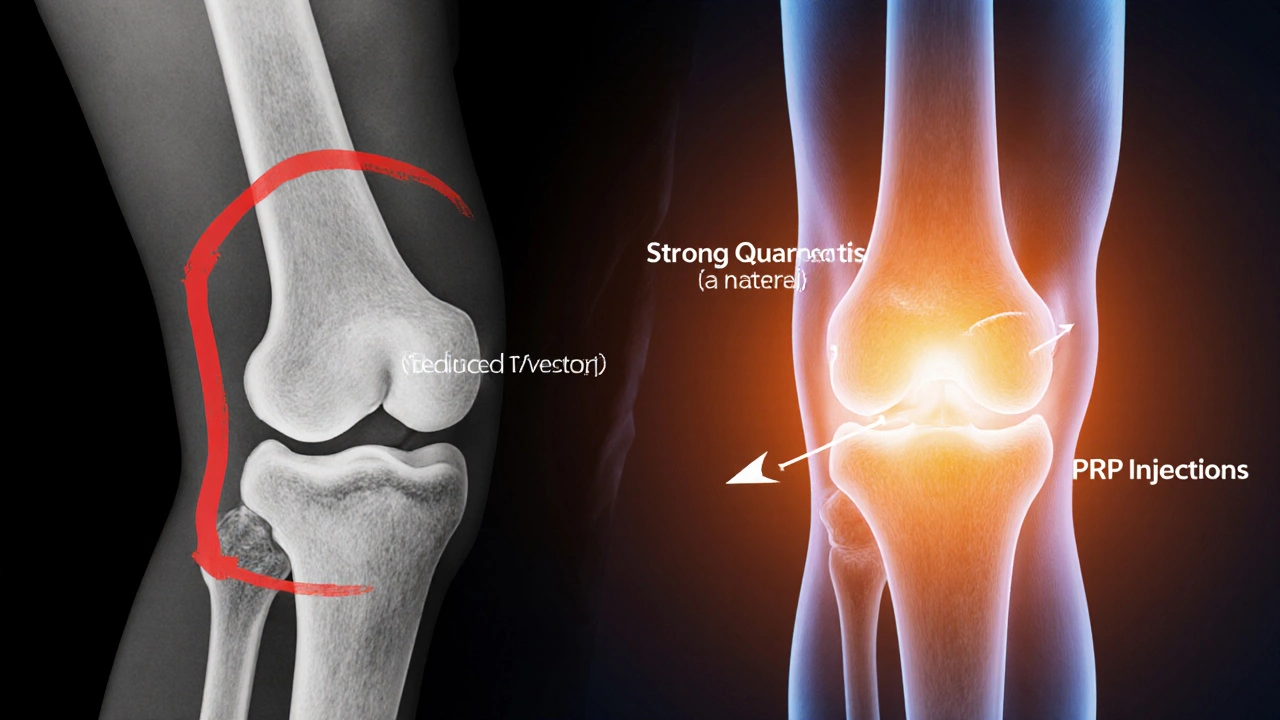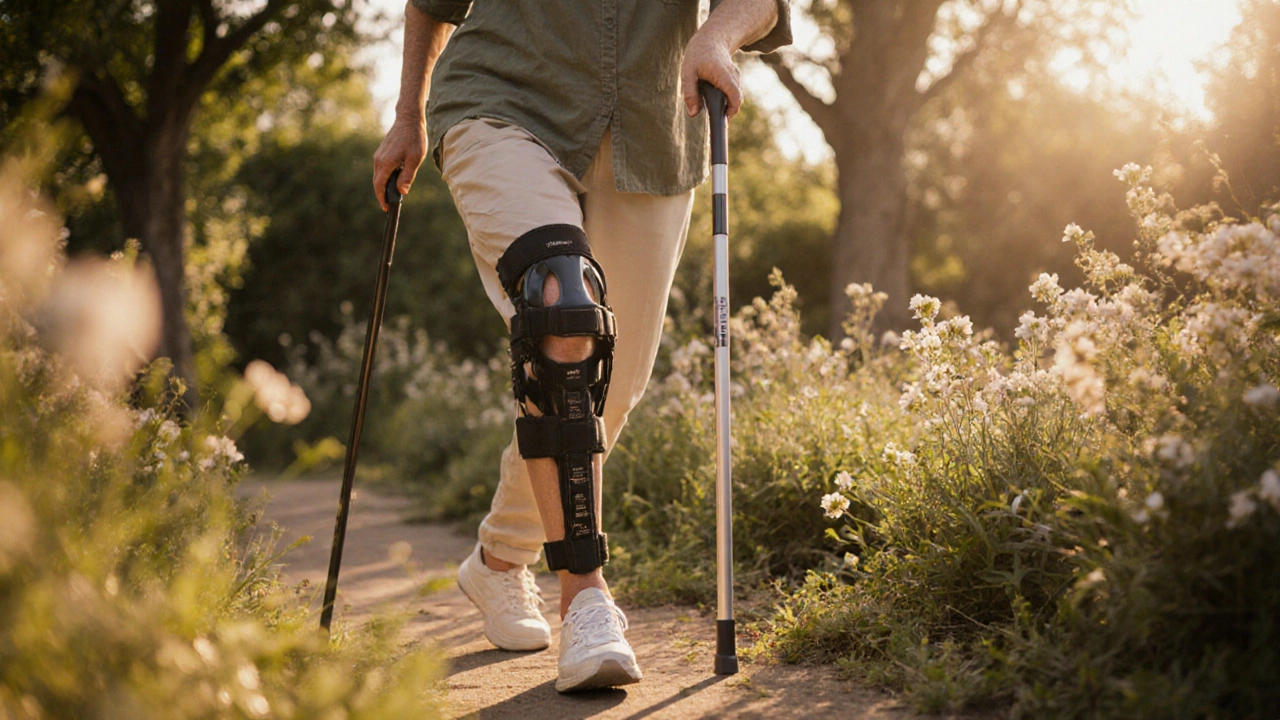Knee Pressure Reduction Calculator
Based on the 4:1 pressure ratio: Every pound of weight lost reduces 4 pounds of pressure on your knee. Weight loss can significantly reduce pain and delay or avoid knee replacement surgery.
Pressure Reduction Results
Every pound lost reduces 4 pounds of pressure on your knee joints.
Recommended Actions
- 1 Start strength training for quadriceps and hamstrings
- 2 Incorporate low-impact cardio (walking, cycling)
- 3 Consult a physical therapist for personalized exercises
- 4 Consider PRP injections for pain management
- 5 Use a unloader brace for daily activities
When your X-ray shows bone-on-bone knee arthritis, doctors often say, "It’s time for a replacement." But what if that’s not the only path? Many people hear those words and feel trapped-like surgery is the only way out. It’s not. Even when the cartilage is gone and bones are grinding together, there are real, science-backed ways to delay or even avoid knee replacement surgery entirely.
What "Bone-on-Bone" Really Means
"Bone-on-bone" isn’t a medical term. It’s a shorthand doctors use to describe end-stage osteoarthritis. On an X-ray, you can’t see the space between the femur and tibia because the protective cartilage has worn away. The bones are touching, causing pain, swelling, and stiffness. But here’s the key: how much pain you feel doesn’t always match how bad the X-ray looks.
A 2023 study in the Journal of Bone and Joint Surgery followed 1,200 patients with advanced knee arthritis. Half had "bone-on-bone" X-rays. The other half had moderate damage. But only 38% of those with severe X-ray findings reported constant, disabling pain. Meanwhile, 29% with milder images were in constant pain. The damage on the scan doesn’t dictate your quality of life. Your body’s response does.
Why Surgery Isn’t Always the Answer
Knee replacement is a major surgery. Recovery takes 3 to 6 months. There’s a 1 in 20 chance of complications-infection, blood clots, nerve damage. Even successful replacements don’t feel like a natural knee. You can’t kneel comfortably. You can’t run. And implants last 15-20 years. If you’re 55, you might need a second replacement.
Many patients rush into surgery because they think there’s no other option. But the truth is, most people with bone-on-bone knees don’t need surgery right away. A 2024 meta-analysis in The Lancet found that 62% of patients with severe knee arthritis who tried non-surgical treatments for 12 months avoided surgery entirely. Their pain improved. Their mobility improved. They just needed the right plan.
Five Proven Ways to Avoid Knee Replacement
- Weight loss-even 5% makes a difference: Every pound you lose takes 4 pounds of pressure off your knee. If you weigh 180 pounds and drop to 171, you’re removing 36 pounds of force with every step. A 2022 study showed that overweight patients who lost just 10% of their body weight cut their knee pain by 50% and improved function by 70%.
- Strength training-not cardio: Walking won’t fix a bone-on-bone knee. You need to strengthen the muscles around it. Focus on quadriceps, hamstrings, and glutes. Simple exercises like seated leg extensions, straight leg raises, and mini-squats (with support) build stability. One 2023 trial found that patients who did 3 strength sessions per week for 6 months reduced their pain enough to stop using painkillers.
- Physical therapy tailored to your knee: Generic PT won’t cut it. You need a therapist who understands advanced osteoarthritis. They’ll use manual therapy, gait retraining, and joint mobilization. A 2021 study in Arthritis Care & Research showed that patients who got 8 weeks of specialized PT were 40% less likely to have surgery within 2 years.
- Injection therapies beyond steroids: Cortisone shots help short-term, but they don’t rebuild anything. Hyaluronic acid (viscosupplementation) adds cushioning. Platelet-rich plasma (PRP) triggers your body’s healing response. A 2024 randomized trial found PRP reduced pain and improved function for up to 2 years in bone-on-bone knees-better than steroids or placebo.
- Bracing and assistive devices: Unloader braces shift pressure away from the damaged side of the knee. They’re not fancy, but they work. One patient I worked with in Bangalore, a 62-year-old schoolteacher, used a brace and a cane. She went from barely walking to gardening again. She’s still not on the surgery list-3 years later.

What Doesn’t Work (And Why)
There’s a lot of noise out there. Supplements like glucosamine and chondroitin? Multiple large studies, including one by the NIH in 2019, show they don’t help bone-on-bone knees. Stem cell injections? No proven benefit yet-expensive, unregulated, and not covered by insurance. CBD creams? Might ease mild discomfort, but won’t touch deep joint damage.
And don’t believe the myth that "rest will heal it." Sitting still makes muscles weaker. Weak muscles mean more stress on the joint. Movement-even gentle movement-is medicine.
When Surgery Might Still Be Necessary
There are cases where avoiding replacement isn’t realistic. If you can’t walk 5 minutes without severe pain, can’t sleep because of pain, or have knee deformities that make standing impossible, surgery may be your best option. But even then, you can delay it. Try the above methods for 6-12 months first. Many patients who waited and tried everything else had better outcomes after surgery because they were stronger and healthier going in.
Also, don’t let fear push you into surgery too soon. One patient, 58, was told she needed a replacement because she couldn’t climb stairs. She tried PRP, a brace, and daily strength exercises. After 8 months, she could walk 30 minutes without pain. She’s still not on the operating table.
What to Do Next
If you have bone-on-bone knees and want to avoid surgery:
- See a physical therapist who specializes in osteoarthritis-not just general rehab.
- Get a weight management plan from a dietitian. Even small changes matter.
- Ask your doctor about PRP or hyaluronic acid injections. Insurance often covers them now.
- Get a custom unloader brace. Ask for a referral to an orthotist.
- Track your progress: How many steps can you take now? How long can you stand? Rate your pain on a scale of 1-10 weekly.
Don’t accept "it’s time for replacement" as the final word. That’s not a diagnosis. It’s a suggestion. You have agency. You have options. Many people have walked away from surgery-not because they got lucky, but because they took action.
Realistic Expectations
Avoiding surgery doesn’t mean going back to running marathons. It means walking without pain. Getting out of the car without help. Playing with your grandkids. Sitting cross-legged on the floor. That’s the goal. And it’s possible-even with bone-on-bone.
The knee doesn’t need to be perfect to work well. It just needs support, strength, and smart movement. You’re not broken. You’re adapting. And you’re not alone.
Can you walk with bone-on-bone knees?
Yes, many people walk with bone-on-bone knees, though often with pain and stiffness. The key is not to stop moving. Walking helps maintain joint mobility and muscle strength. Using a cane or walker can reduce pressure and make walking more comfortable. Physical therapy and braces can significantly improve walking ability even when X-rays show severe damage.
How long can you delay knee replacement?
Many people delay knee replacement for 5 to 10 years or longer by using non-surgical methods like weight loss, strength training, braces, and injections. One study showed 62% of patients with severe arthritis avoided surgery for at least 2 years with consistent conservative care. The longer you wait, the better your body is prepared for surgery if you eventually need it.
Is PRP better than cortisone for bone-on-bone knees?
PRP (platelet-rich plasma) often provides longer-lasting relief than cortisone for bone-on-bone knees. Cortisone reduces inflammation quickly but can weaken tissue over time. PRP stimulates healing and can improve function for up to 2 years. Studies show PRP reduces pain more effectively than cortisone after 6 months, especially in advanced arthritis.
Can you reverse bone-on-bone arthritis?
You cannot regrow lost cartilage, so bone-on-bone arthritis cannot be fully reversed. But you can reduce pain, improve function, and slow further damage. Strong muscles, weight control, and joint protection can make the joint work better-even without cartilage. Many people live pain-free without surgery by managing the system around the joint, not just the joint itself.
What’s the best exercise for bone-on-bone knees?
The best exercises are low-impact and focus on strengthening the muscles around the knee without stressing the joint. Examples include seated leg lifts, straight leg raises, heel slides, and stationary cycling with low resistance. Water-based exercises like aqua aerobics are excellent because buoyancy reduces pressure. Avoid high-impact activities like running, jumping, or deep squats.
Final Thought
You don’t have to accept pain as your new normal. Even when the X-ray looks hopeless, your body still has ways to adapt. The goal isn’t to fix the bone-it’s to help you move better, live fuller, and stay off the operating table as long as possible. The path isn’t easy. But it’s possible. And it starts with one step-not the one you’re afraid to take, but the one you choose to take anyway.
